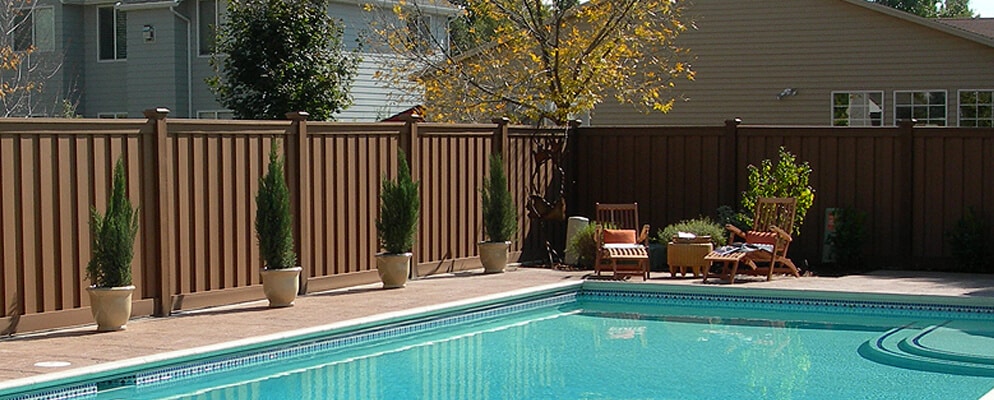Choosing the right materials can significantly impact the sustainability and practicality of a project. This is especially true for fencing, where the material not only defines the perimeter but also contributes to a property’s aesthetic and functional qualities. Composite fencing, such as Trex Composite Fencing, offers a modern solution by blending the strength of traditional materials with the benefits of advanced composites.
What is Trex Composite Fencing?
Composite fencing is a modern fencing solution that combines the durability and strength of traditional materials with the low-maintenance benefits of composite materials.
Now, unlike traditional wood fencing, which is prone to rotting, warping, and insect damage, composite fencing is engineered to withstand the elements and maintain its integrity over time.
Trex composite fencing is composed of a blend of recycled wood fibers and plastic materials, such as polyethylene or polypropylene.
These materials are mixed together with binding agents and pigments to create a durable and weather-resistant fencing material.
The result is a fencing product that offers the natural look and feel of wood with the added benefits of enhanced durability and longevity.
One of the key features of composite fencing is its resistance to rot, decay, and insect infestation. Because composite materials are impervious to moisture, they are not susceptible to the same issues that plague traditional wood fencing.
This makes composite fencing an ideal choice for areas with high humidity, frequent rainfall, or exposure to moisture, such as coastal regions or rainy climates.
The Manufacturing Process of Trex Composite Fencing
The manufacturing process of composite fencing involves several steps to create a durable and resilient fencing material. Here’s an overview of the typical manufacturing process:
- Material Selection
The manufacturing process begins with the selection of high-quality raw materials, including recycled wood fibers and plastic polymers. These materials are chosen for their strength, durability, and weather-resistant properties.
- Material Preparation
Once the raw materials are selected, they undergo a process of cleaning and preparation to remove any impurities or contaminants.
The wood fibers are typically sourced from post-consumer or post-industrial sources, such as recycled wood pallets or construction waste, while the plastic polymers are derived from recycled plastic bottles or other plastic products.
- Mixing
The cleaned and prepared materials are then mixed together in precise proportions to create a homogeneous blend. This blending process ensures that the wood fibers and plastic polymers are evenly distributed throughout the mixture, resulting in a consistent and uniform final product.
- Extrusion
The blended material is then fed into an extruder, which heats and compresses the mixture to form a molten composite material. The extrusion process shapes the material into the desired profile, such as fencing panels or pickets, and imparts texture and grain patterns to mimic the appearance of natural wood.
- Cooling and Solidification
Once the composite material has been extruded into the desired shape, it is cooled and solidified to achieve its final form. This may involve passing the material through a series of cooling chambers or using water-cooled molds to accelerate the solidification process.
- Finishing
Finally, the finished composite fencing products undergo any necessary finishing touches, such as cutting to size, adding decorative elements, or applying surface treatments to enhance durability and appearance.
What Makes Composite Fencing Strong?
Composite fencing derives its strength from a combination of factors inherent in its composition and manufacturing process. Here’s a closer look at what makes composite fencing a robust and durable fencing option:
- Material Composition
Composite fencing is typically made from a blend of recycled wood fibers and plastic polymers. This combination of materials creates a composite material that is stronger and more resilient than traditional wood alone. The wood fibers provide natural strength and rigidity, while the plastic polymers enhance durability and resistance to environmental factors.
- Bonding Agents
During the manufacturing process, binding agents are used to bind the wood fibers and plastic polymers together. These binding agents create a strong bond between the materials, ensuring that the composite material maintains its structural integrity under stress.
- Weather Resistance
Composite fencing is designed to withstand the elements, including moisture, UV exposure, and temperature fluctuations. The plastic polymers used in composite fencing are inherently weather-resistant, preventing rot, decay, and warping that can occur with traditional wood fencing.
- Dimensional Stability
Unlike wood fencing, which can expand, contract, and warp over time in response to changes in temperature and humidity, composite fencing maintains its dimensional stability. This means that composite fencing panels and pickets remain straight, flat, and true, even in challenging environmental conditions.
- Structural Design
Composite fencing panels and pickets are engineered for strength and stability, with reinforced internal structures and strategic placement of structural elements. This structural design ensures that composite fencing can withstand wind, impact, and other forces without compromising its integrity.
Technological Advancements in Trex Composite Fencing
Composite fencing derives its strength from a combination of factors inherent in its composition and manufacturing process. Here’s a closer look at what makes composite fencing a robust and durable fencing option:
Material Composition
Composite fencing is typically made from a blend of recycled wood fibers and plastic polymers. This combination of materials creates a composite material that is stronger and more resilient than traditional wood alone. The wood fibers provide natural strength and rigidity, while the plastic polymers enhance durability and resistance to environmental factors.
Bonding Agents
During the manufacturing process, binding agents are used to bind the wood fibers and plastic polymers together. These binding agents create a strong bond between the materials, ensuring that the composite material maintains its structural integrity under stress.
Weather Resistance
Composite fencing is designed to withstand the elements, including moisture, UV exposure, and temperature fluctuations. The plastic polymers used in composite fencing are inherently weather-resistant, preventing rot, decay, and warping that can occur with traditional wood fencing.
Dimensional Stability
Unlike wood fencing, which can expand, contract, and warp over time in response to changes in temperature and humidity, composite fencing maintains its dimensional stability. This means that composite fencing panels and pickets remain straight, flat, and true, even in challenging environmental conditions.
What is the Best Composite Fencing?
When considering the best composite fencing on the market, Trex stands out for several reasons:
- Durability and Strength: Trex fencing is designed to outlast traditional wood by resisting environmental stresses such as moisture, UV exposure, and temperature fluctuations.
- Low Maintenance: Unlike wood, Trex fencing does not require painting, staining, or sealing, saving time and money over the fence’s lifespan.
- Sustainability: Made from 95% recycled materials, Trex fencing supports environmental conservation efforts while providing a strong, beautiful fencing solution.
- Aesthetic Options: Trex offers a variety of styles and colors, allowing for customization to fit any design aesthetic.
The Role of Trex Fencing in Green Building Standards
Trex Fencing not only enhances a property’s perimeter but also contributes significantly to LEED certification and other green building standards. By using Trex, projects can earn points in categories like Materials and Resources (MR) and Innovation in Design (ID). This is due to its high recycled content and the reduction in VOC emissions typically associated with fencing maintenance.
Final Thought
Trex Composite Fencing provides a robust, long-lasting solution that marries traditional material strengths with modern technological advancements. Its resistance to common fencing issues, combined with low maintenance needs and environmental benefits, makes it an excellent choice for both residential and commercial applications. As technology advances, the future of composite fencing looks promising, with Trex leading the way.
For those considering a reliable, aesthetically pleasing, and sustainable fencing option, Trex Composite Fencing offers a premier choice. Get started on your project today and take a step towards a greener, more durable fencing solution.




